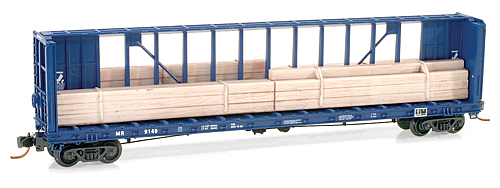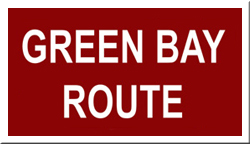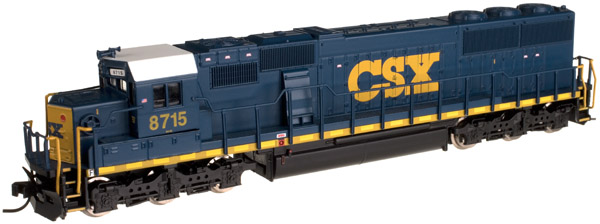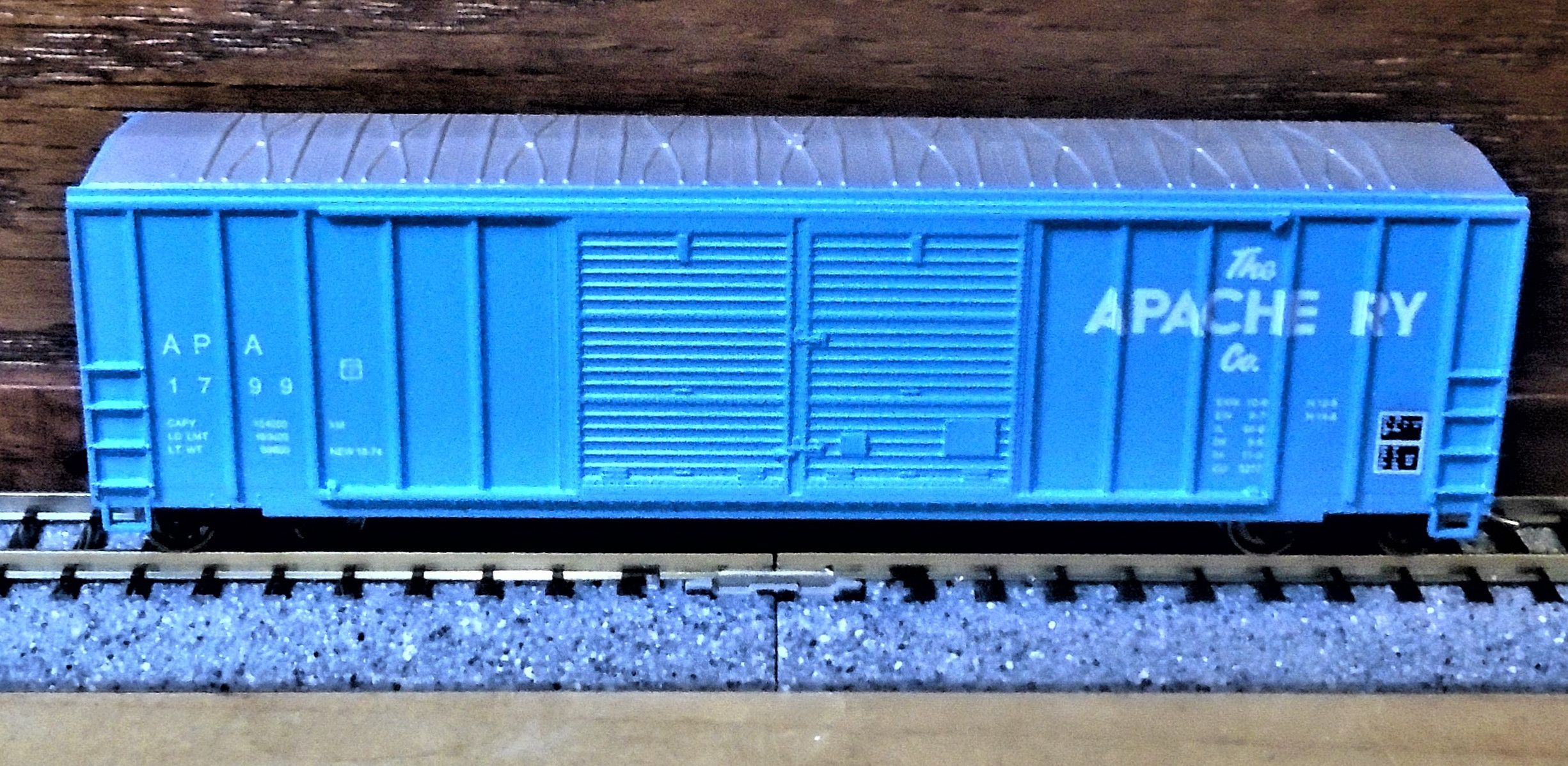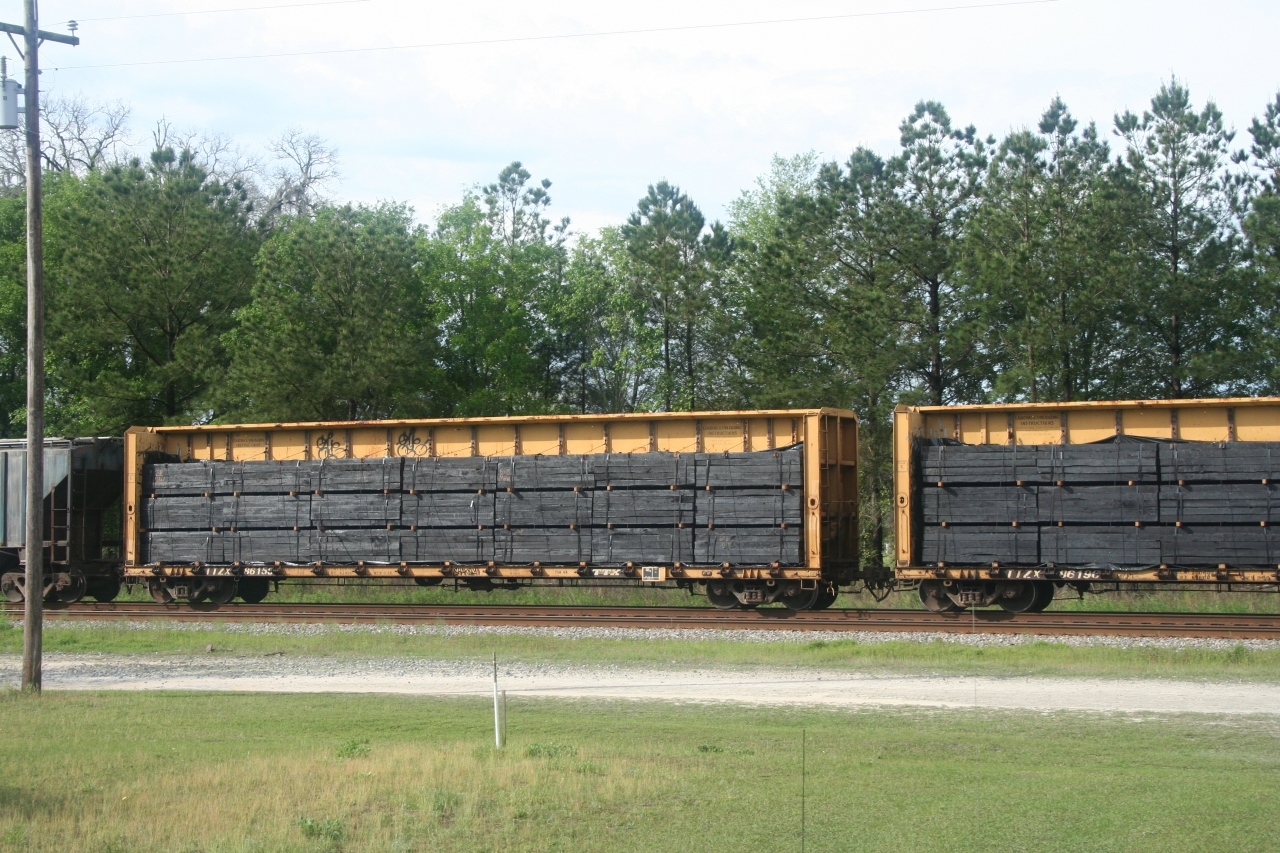Micro-Trains - 053 00 730 - Flatcar, 60 Foot, Centerbeam - McCloud River - 9149
Click to see the details
history
Click to see the details
collector
| Stock Number | 053 00 730 |
| Secondary Stock Number | 053 00 730 |
| Original Retail Price | $27.90 |
| Brand | Micro-Trains |
| Manufacturer | Micro-Trains Line |
| Body Style | Micro-Trains 053 Flatcar 60 Foot Centerbeam |
| Prototype Vehicle | Flatcar, 60 Foot, Centerbeam (Details) |
| Road or Company Name | McCloud River (Details) |
| Reporting Marks | MR |
| Road or Reporting Number | 9149 |
| Paint Color(s) | Blue |
| Print Color(s) | White |
| Coupler Type | MT Magne-Matic Knuckle |
| Wheel Type | Injection Molded Plastic |
| Wheel Profile | Standard |
| Release Date | 2007-12-01 |
| Item Category | Rolling Stock (Freight) |
| Model Type | Flatcar |
| Model Subtype | 60 Foot |
| Model Variety | Centerbeam |
| Prototype Region | North America |
| Prototype Era | NA Era III: Transition (1939 - 1957) |
| Scale | 1/160 |
| UPC/GTIN12 Number | 695140020881 |
Prototype History:
Centerbeam flatcars, centerbeams, center partition railcars or commonly referred to as lumber racks are specialty cars designed for carrying bundled building supplies such as dimensional lumber, wallboard, and fence posts. They are essentially bulkhead flatcars that have been reinforced by a longitudinal I-beam, often in the form of a Vierendeel truss, sometimes reinforced by diagonal members, but originally in the form of stressed panels perforated by panel-lightening "opera windows", often oval, egg-shaped or rectangular. They must be loaded symmetrically, with half of the payload on one side of the centerbeam and half on the other to avoid tipping over.
Road Name History:
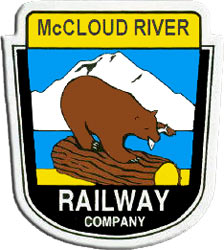 The MCR was originally built as the McCloud River Railroad chartered on January 22, 1897, as a forest railway bringing logs to the company sawmill on the Southern Pacific Railroad at a place called Upton a few miles north of Mount Shasta, California. By 1901 the company sawmill was moved to McCloud, and the distance for hauling lumber produced at McCloud was reduced to 17.8 miles (28.6 km) by shifting the junction south to Mount Shasta in 1906. The locomotives shifted from wood to oil fuel as the railroad extended into the forests east of McCloud in 1907. Trains brought logs to the McCloud sawmill from the east, and carried lumber from the sawmill west to the Southern Pacific.
The MCR was originally built as the McCloud River Railroad chartered on January 22, 1897, as a forest railway bringing logs to the company sawmill on the Southern Pacific Railroad at a place called Upton a few miles north of Mount Shasta, California. By 1901 the company sawmill was moved to McCloud, and the distance for hauling lumber produced at McCloud was reduced to 17.8 miles (28.6 km) by shifting the junction south to Mount Shasta in 1906. The locomotives shifted from wood to oil fuel as the railroad extended into the forests east of McCloud in 1907. Trains brought logs to the McCloud sawmill from the east, and carried lumber from the sawmill west to the Southern Pacific.
The railroad remained primarily a logging railroad with several different owners over the following years including: U.S. Plywood Corporation (1963), U.S. Plywood-Champion Papers (1969), Champion International (1972), and Itel Corporation (1977). The railroad was sold to Jeff E. and Verline Forbis (4-Rails, Inc.) on July 1, 1992. On June 28, 2005, the railroad petitioned the STB to abandon most of its line. Service on all line east of the McCloud Sawmill (now abandoned) has been terminated. A small section of line between McCloud CA and Mount Shasta CA remained open briefly for excursion and dinner train service. As timber demand declined, the railroad slowly cut back although new ownership also led to its downfall. In 2009, the railroad ceased operation and closed down. The property is now for sale as a rail/trail as of 2012.
From Wikipedia

The railroad remained primarily a logging railroad with several different owners over the following years including: U.S. Plywood Corporation (1963), U.S. Plywood-Champion Papers (1969), Champion International (1972), and Itel Corporation (1977). The railroad was sold to Jeff E. and Verline Forbis (4-Rails, Inc.) on July 1, 1992. On June 28, 2005, the railroad petitioned the STB to abandon most of its line. Service on all line east of the McCloud Sawmill (now abandoned) has been terminated. A small section of line between McCloud CA and Mount Shasta CA remained open briefly for excursion and dinner train service. As timber demand declined, the railroad slowly cut back although new ownership also led to its downfall. In 2009, the railroad ceased operation and closed down. The property is now for sale as a rail/trail as of 2012.
From Wikipedia
Brand/Importer Information:
Micro-Trains is the brand name used by both Kadee Quality Products and Micro-Trains Line. For a history of the relationship between the brand and the two companies, please consult our Micro-Trains Collector's Guide.
Manufacturer Information:
 Micro-Trains Line split off from Kadee Quality Products in 1990. Kadee Quality Products originally got involved in N-Scale by producing a scaled-down version of their successful HO Magne-Matic knuckle coupler system. This coupler was superior to the ubiquitous 'Rapido' style coupler due to two primary factors: superior realistic appearance and the ability to automatically uncouple when stopped over a magnet embedded in a section of track. The success of these couplers in N-Scale quickly translated to the production of trucks, wheels and in 1972 a release of ready-to-run box cars.
Micro-Trains Line split off from Kadee Quality Products in 1990. Kadee Quality Products originally got involved in N-Scale by producing a scaled-down version of their successful HO Magne-Matic knuckle coupler system. This coupler was superior to the ubiquitous 'Rapido' style coupler due to two primary factors: superior realistic appearance and the ability to automatically uncouple when stopped over a magnet embedded in a section of track. The success of these couplers in N-Scale quickly translated to the production of trucks, wheels and in 1972 a release of ready-to-run box cars.
Micro-Trains Line Co. split off from Kadee in 1990 to form a completely independent company. For this reason, products from this company can appear with labels from both enterprises. Due to the nature of production idiosyncrasies and various random factors, the rolling stock from Micro-Trains can have all sorts of interesting variations in both their packaging as well as the products themselves. When acquiring an MTL product it is very important to understand these important production variations that can greatly enhance (or decrease) the value of your purchase.
Please consult our Micro-Trains Collector's Guide

Micro-Trains Line Co. split off from Kadee in 1990 to form a completely independent company. For this reason, products from this company can appear with labels from both enterprises. Due to the nature of production idiosyncrasies and various random factors, the rolling stock from Micro-Trains can have all sorts of interesting variations in both their packaging as well as the products themselves. When acquiring an MTL product it is very important to understand these important production variations that can greatly enhance (or decrease) the value of your purchase.
Please consult our Micro-Trains Collector's Guide
Item created by: Lethe
on 2015-05-31 17:46:30
Last edited by: George on 2024-01-26 20:28:48
If you see errors or missing data in this entry, please feel free to log in and edit it. Anyone with a Gmail account can log in instantly.
Last edited by: George on 2024-01-26 20:28:48
If you see errors or missing data in this entry, please feel free to log in and edit it. Anyone with a Gmail account can log in instantly.


